dBSPL
SENIOR MEMBER

- Joined
- Mar 2, 2018
- Messages
- 7,661
- Reaction score
- 28
- Country
- Location
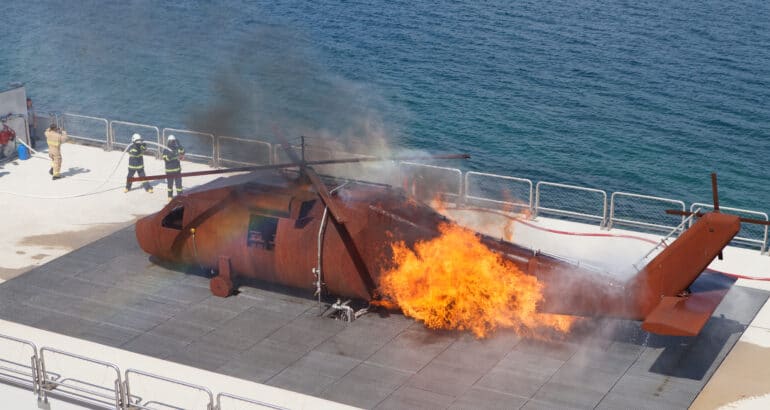
Meteksan Provides World-Class Simulators For Naval Training
Turkish defence solutions provider Meteksan Savunma, known fors ULAQ unmanned surface vessel (with the partnership of ARES Shipyard) and sonar solutions for surface ships and submarines, has been developing simulators to provide navies with an effective, cost-efficient, and safe training environment. 5 countries from different continents use Meteksan's simulators for training naval personnel.Tayfun Ozberk 14 Jul 2022
The need for efficient and effective, high-quality training of naval personnel will continue to grow as operational requirements and equipment capabilities continue to evolve. Real-world training using operational equipment often presents too many challenges:
Risks to personnel safety and equipment damage,
The risk of compromising operational safety,
Limited access to congested operational platforms for training.
In this regard, simulators have evolved to a level where highly realistic scenarios can be used to meet critical needs.
Simulator training in highly realistic operational scenarios is a shorter path to force competency and readiness. Trainers and scenarios can be tailored specifically to meet warfighters’ needs so they can prepare for any situation, from vital procedural training to demanding, high-stress combat operations where learned responses are critical to survival. Such exercises, using validated tactics and procedures, can be repeated many times to develop, build, and maintain core competencies in a safe training environment.
Turkish private company Meteksan Defence has become one of the world’s leading suppliers of naval simulators with its “Damage Control Simulator”, “Fire Fighting Training Simulator” and “Helicopter Escape Training Simulator”. In particular, its high-tech and cost-effective Damage Control Simulator solution has won almost all open tenders around the world in recent years and has become number one in its class with well-deserved recognition.
Meteksan DCSIM – Damage Control Simulator

The Damage Control (DC) capability at sea is a critical factor in maintaining the integrity, stability, and maneuverability of ships. Key to enabling these capabilities is a realistic training environment for ship’s personnel to develop and conduct damage control exercises (DAMCONEX). Consistent and realistic training leads to an optimal level of preparedness that prepares repair teams to respond more efficiently and effectively to actual accidents.
Meteksan Defence DCSIM (abbreviation for Damage Control Simulator) has unique features that increase training effectiveness, operational efficiency and maintainability. The system provides standardised means for crew training from basic to advanced levels with appropriate and comparable assessment reports.

Thanks to the system’s state-of-the-art and fail-safe design, DCSIM provides a safe training environment with adjustable and controllable difficulty levels. The design of the interfaces allows the simulator and training to be controlled in a user-friendly manner, eliminating operator error. DCSIM has been designed in accordance with current international safety guidelines, the Regulations for Prevention of Accidents.
As part of its capabilities, it is possible to configure the number of damages and their types. One of the most important features of the system is the rolling effect. The Damage Control Simulator can roll up to 20 degrees with its hydraulic feet to simulate the sea effect.
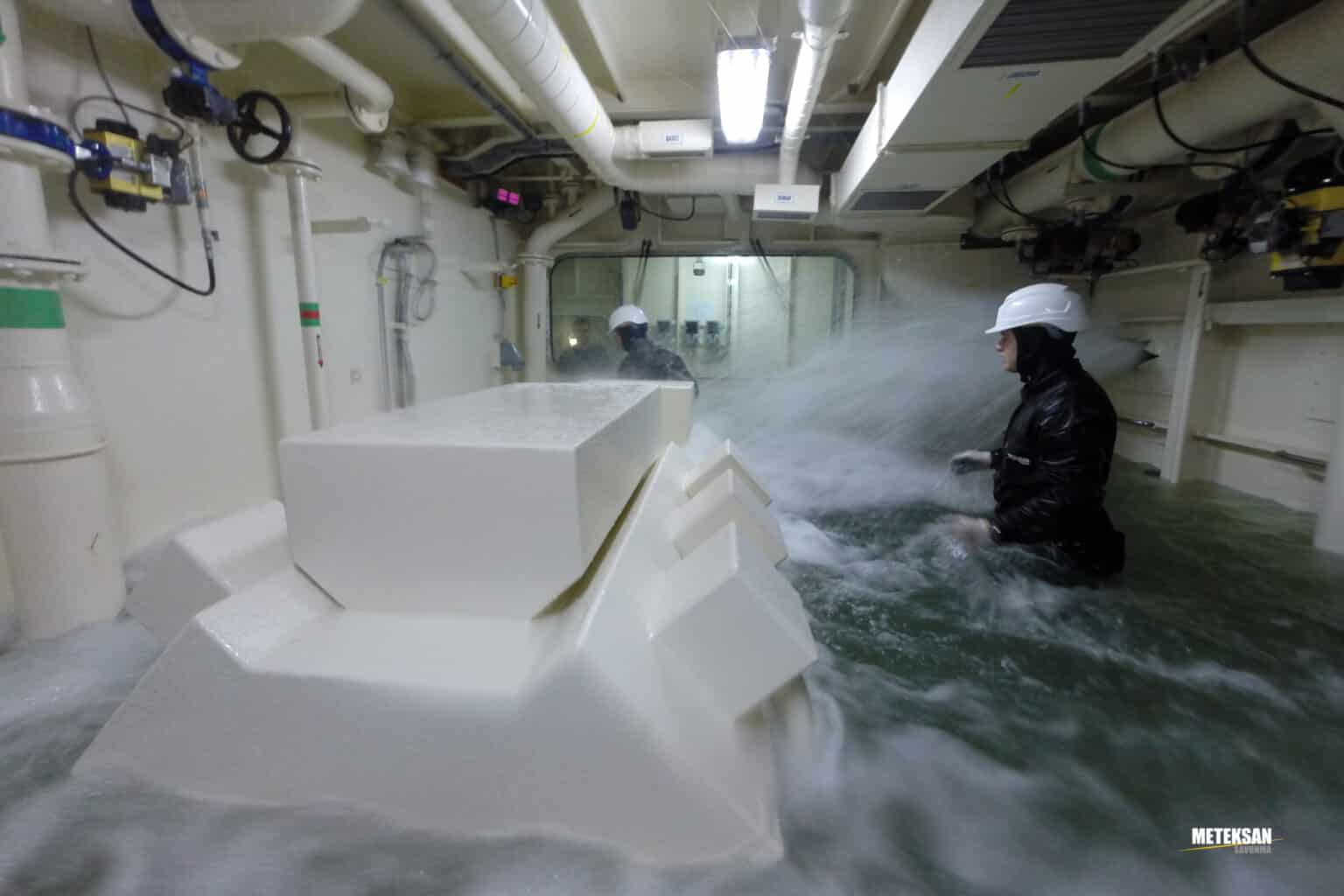
Meteksan DCSIM has unique features that increase training effectiveness, operational efficiency, and maintainability, such as additional training capabilities besides damage training, such as applications for material conditions, plotting, communications, smoke removal, causality training for cable laying, etc., adjustable water level, adjustable hull movement for speed and angle, use of specific lighting and sound effects, preventive maintenance by recording the usage time of critical components by the automation system and timely warning the user for appropriate maintenance, simple troubleshooting system that enables the location of faulty components. Based on foolproof and fail-safe design, where DCSIM is not affected by trainees’ improper use, DCSIM guarantees trainees’ safety even if a failure occurs during execution, such as power failure.
Meteksan Defence’s damage control simulator has been selected by 5 navies from different countries, 4 of which are currently operating successfully.
Meteksan FTSIM – Fire Fighting Training Simulator
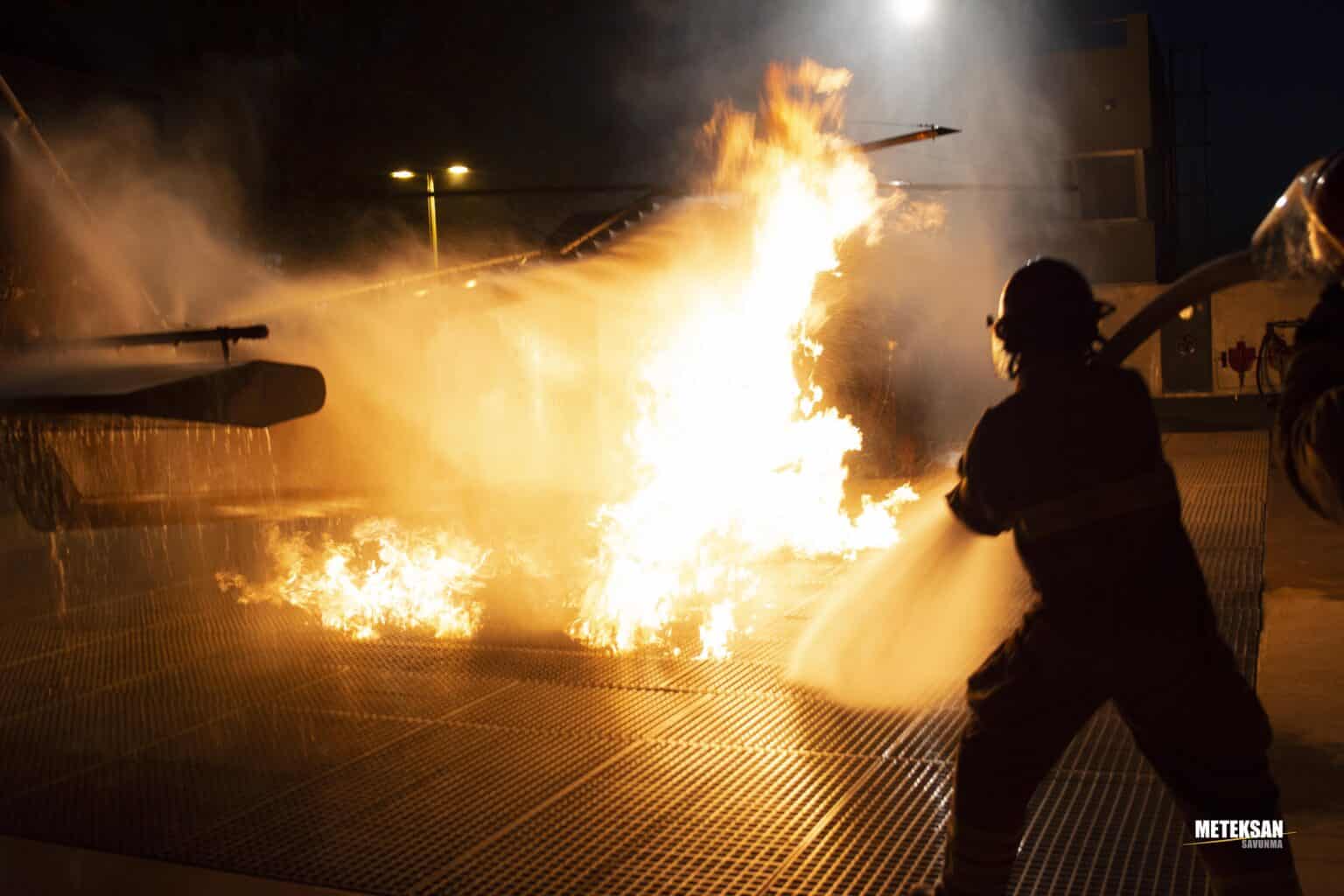
Firefighting simulators are used to reinforce theoretical firefighting training and actual training. They are conducted on a firefighting simulator to increase the affinity of repair team or firefighting crew members who will participate in fighting different types of fires at various locations aboard. The system provides standardized means for crew training from basic to advanced levels with appropriate and comparable assessment reports.
Meteksan Defense’s Fire Suppression Simulator (or FTSIM) provides effective and safe training in a realistic environment where firefighting team members can assume the role of a firefighter and practice tactics and procedures by interacting with fixed and portable firefighting equipment under simulated conditions without risking life or property. Thanks to the system’s state-of-the-art, fail-safe design, FTSIM provides a safe training environment with adjustable and controllable levels of difficulty.
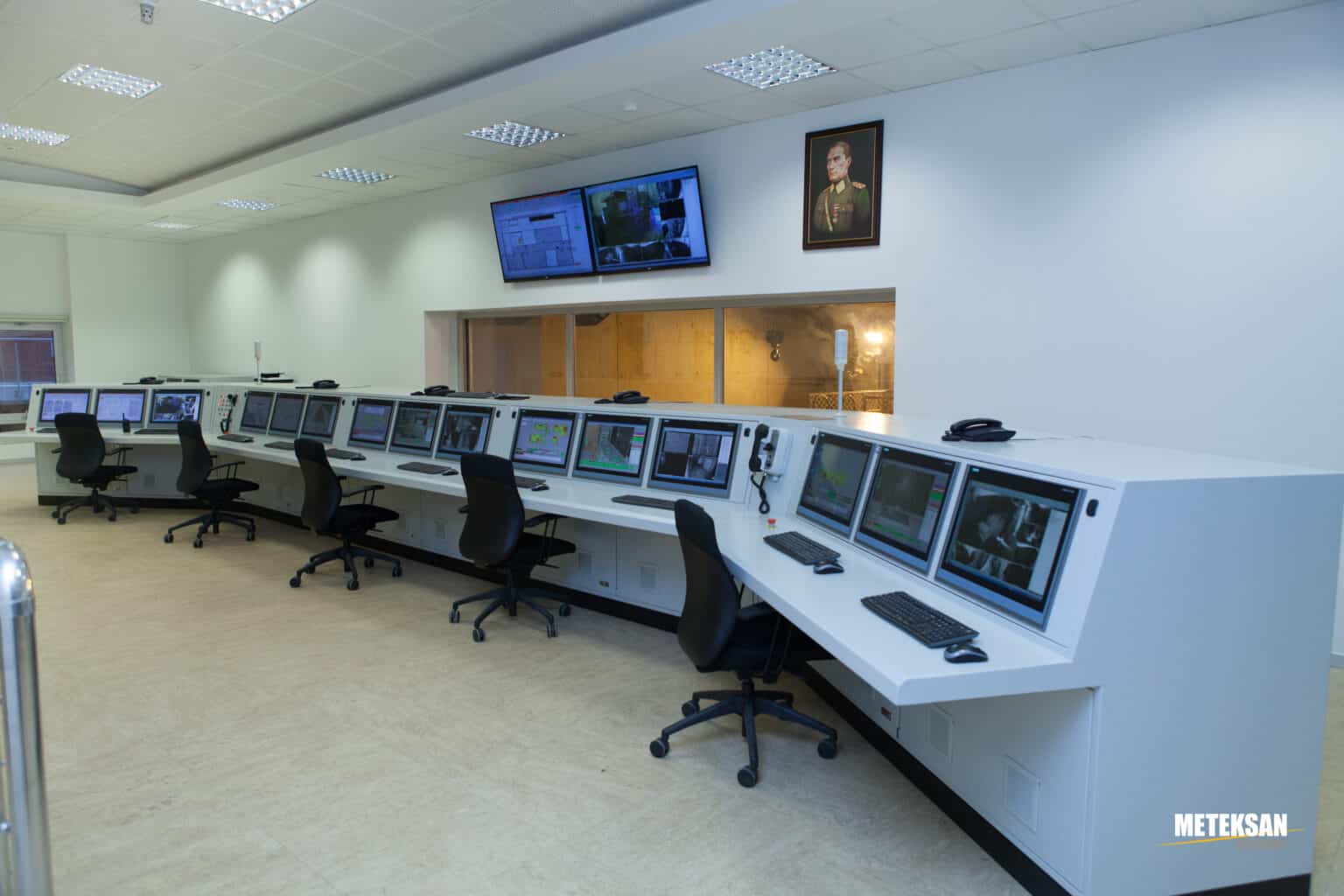
FTSIM was built in accordance with current international guidelines and accident prevention regulations. DIN Rules and procedures are the basis for the design and installation of the simulator and allow for proper operation of the training facility for firefighters and first responders.
FTSIM has unique features that increase training effectiveness, operational efficiency, and maintainability by enabling the fighting of various classes of fires, how to extinguish them, and how to use and maintain firefighting systems and equipment; it prepares the crew to deal with emergency situations that may arise from an on-board fire. It familiarises each crew with the duties they must perform in the event of an actual emergency.
It is extremely important that the fire drill be as realistic as possible to make the crew aware of the situations that may occur during a fire. Consistent and realistic training will result in an optimal level of preparedness that will prepare repair crew members to respond more efficiently and effectively to actual accidents.
The more they learn, the more they will be able to effectively contribute to the safety of your vessel.
Meteksan Defence has developed several firefighting simulators for the Turkish Navy and the Akkuyu Nuclear Power Plant.
Meteksan HUET – Helicopter Underwater Escape Training Simulator
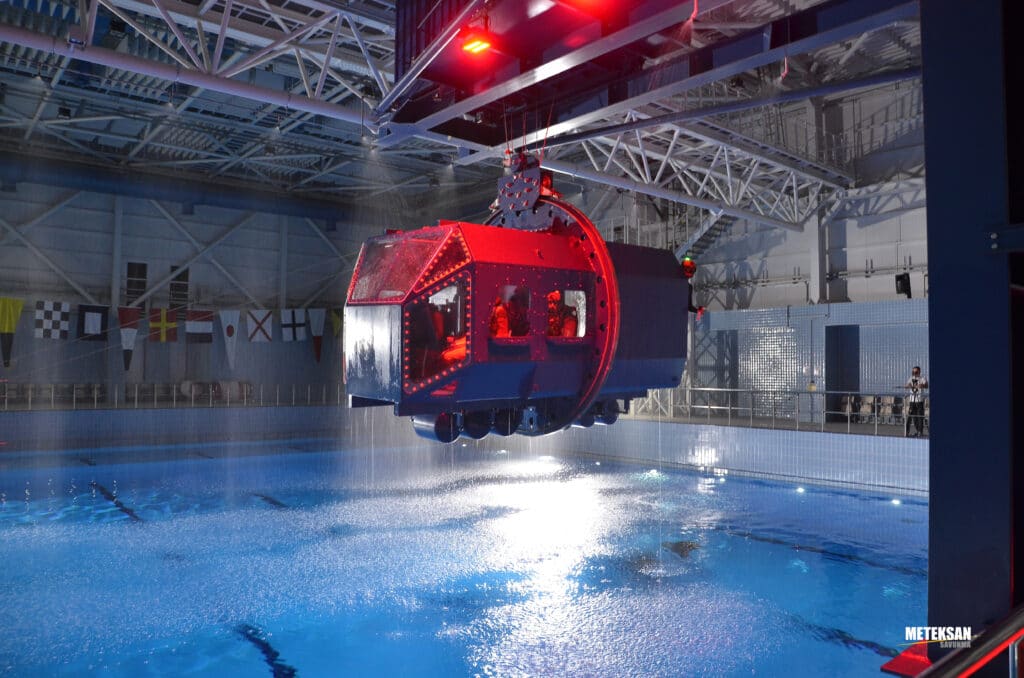
The HUET facility was designed and built by Meteksan Defence based on international standards and OPITO criteria (an international organization defining qualification standarts) for personnel who regularly travel by helicopter, to provide the skills and knowledge of what to do in an emergency situation when a ditched helicopter must be abandoned to survive at sea.
Environmental conditions such as weather, sea state, day/night time and noise are simulated to conduct realistic training. The platforms for simulating rescue from the helicopter, landing with a parachute, and the ship’s deck provide a comprehensive training opportunity.
The trainer consists of a dummy helicopter with movable exits/windows that can be controllably lowered into the pool and rotate up to 180 degrees in either direction. Trainees are expected to exit the model using the emergency breathing system (EBS) and be rescued from the simulated helicopter cabin platform above the pool. The facility, including the pool, contains systems to simulate real environments, namely wave generators, day/night differences, wind, and sea state effects. It provides the necessary means for OPITO-certified crew training.
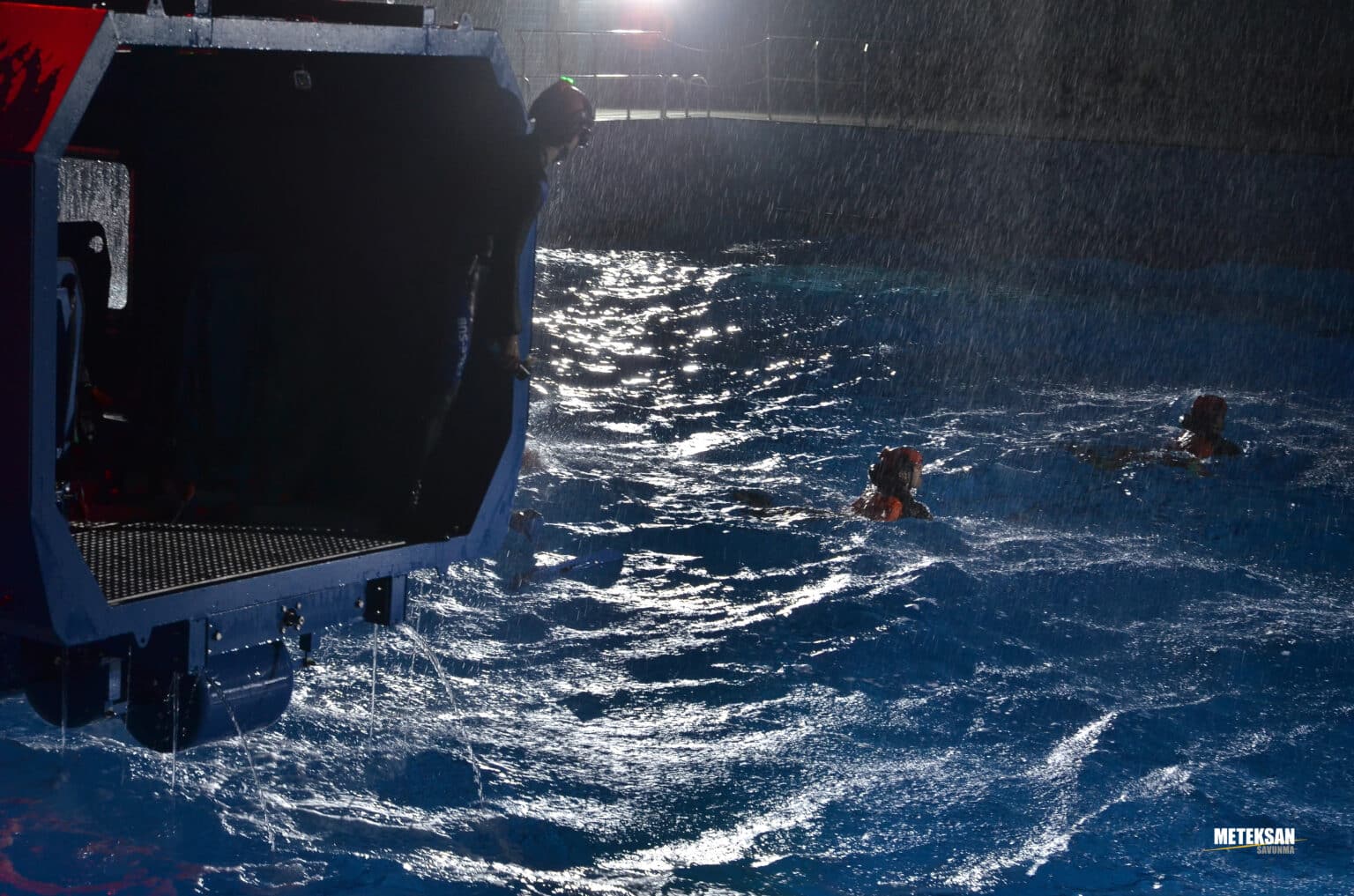
The purpose-built, state-of-the-art facility includes several different training options, which include the Helicopter Underwater Escape Trainer as well as the components for discrete training:
- Simulated rescue helicopter to enable rescue activities,
- Simulated landing with parachute,
- Portable SWET chairs for shallow water escape training (SWET).
Naval News Comment
As defence spending has increased tremendously in recent years, straining navies’ budgets, simulators provide a safe and cost-effective environment for ship crews. As ships incur costs such as diesel oil and depreciation, the frequency of training is kept within a certain range. However, evolving technology offers the Navy several alternatives in this regard.Well-designed simulators are the best helpers in this regard. In addition to providing low-cost training, simulators can be used to try out many scenarios that cannot be tested at sea, so personnel are better prepared for real-life situations.
Meteksan is one of the first companies in this field. In addition to the Turkish Naval Forces, two navies in the Middle East and South Asia are also training their personnel with simulators from Meteksan. Meteksan is in contact with users of the simulators, which have been supplied to and operated by other navies, to increase training effectiveness, operational efficiency, and maintainability. Based on their recommendations and findings, we will always add additional capabilities and improve the training tools.
The need for simulators will continue to increase during this time when defense spending is increasing but the need for personnel training is not decreasing.

Meteksan Provides World-Class Simulators for Naval Training - Naval News
Meteksan Savunma has been developing simulators to provide navies with an effective, cost-efficient, and safe training environment.
@Bilal Khan (Quwa)
